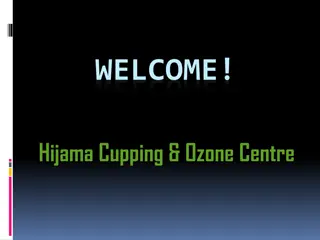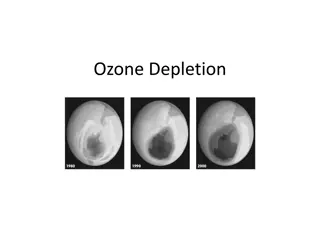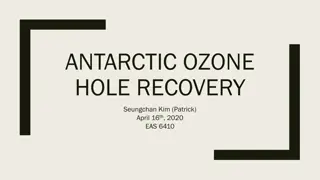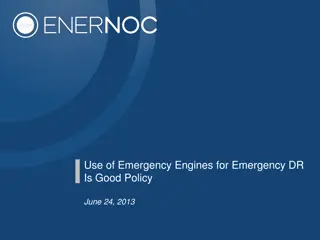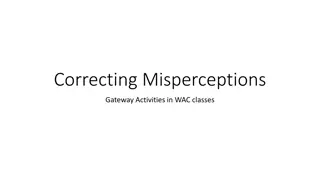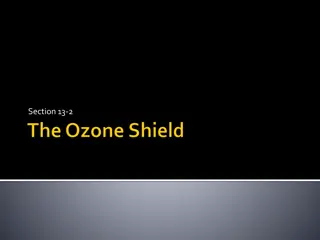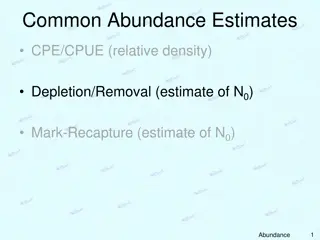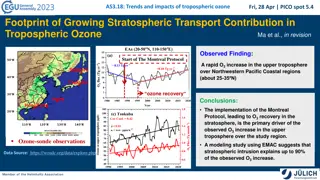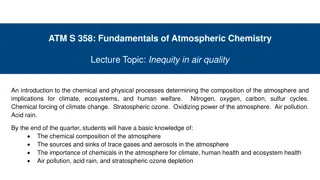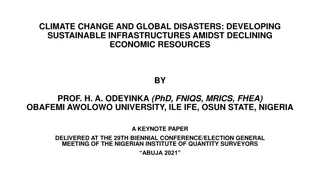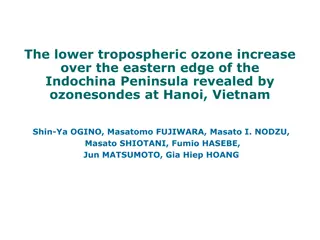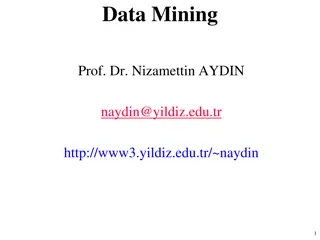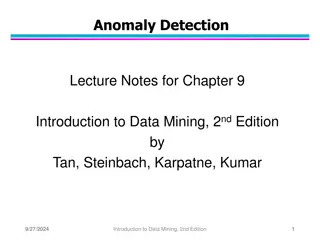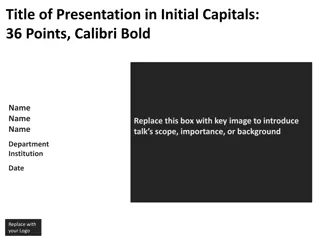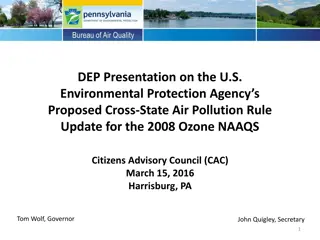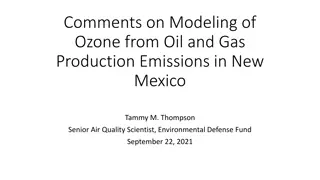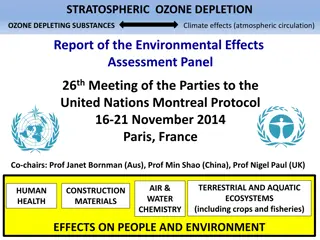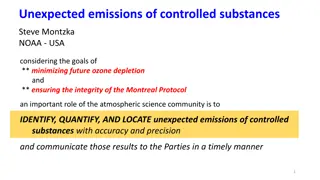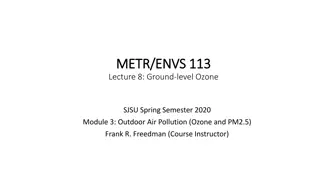Insights from 2022 Scientific Assessment of Ozone Depletion
The 2022 Scientific Assessment of Ozone Depletion, led by David Plummer, addresses key issues like Ozone Depleting Substances, HFCs, Global and Polar Stratospheric Ozone, Climate Impacts, Stratospheric Aerosol Injection, and more. Chapter details reveal decreasing trends in Ozone Depleting Substances, discrepancies in emission estimates, the impact of HFCs on climate mitigation, observed trends in global ozone recovery, and emerging uncertainties in observed total ozone levels.
Download Presentation

Please find below an Image/Link to download the presentation.
The content on the website is provided AS IS for your information and personal use only. It may not be sold, licensed, or shared on other websites without obtaining consent from the author. Download presentation by click this link. If you encounter any issues during the download, it is possible that the publisher has removed the file from their server.
E N D
Presentation Transcript
Overview of issues addressed by the 2022 Scientific Assessment of Ozone Depletion David Plummer All credit to the Chapter Lead Authors, Co-Authors and Contributing Authors
Overview of Chapters familiar chapter structure 1) Ozone Depleting Substances 2) HFCs 3) Global Stratospheric Ozone 4) Polar Stratospheric Ozone 5) Stratospheric Ozone and Climate 6) Stratospheric Aerosol Injection (SAI) 7) Scenarios and Information for Policymakers
Chapter 1 ODSs (LAs: J. Laube and S. Tegtmeier) updated trends / emissions of Ozone Depleting Substances tropospheric concentrations of most ODSs continue to decrease a couple of minor CFCs (ppt-level) showed stable or increasing concentrations as discussed in the SPARC report on CCl4, there continues to be a discrepancy between bottom-up (reported) and top-down emission estimates Figure 14 from SPARC Report No. 7, Q. Liang, P. Newman and S. Reimann (Eds), 2016
Chapter 1 - ODSs derived CFC-11 emissions for 2019 returned to levels similar to that over 2008 - 2012 Two estimates of CFC-11 emissions using time varying dynamics from (a) WACCM and (b) TOMCAT. Figure 4 from Montzka et al. (2021)
Chapter 2 HFCs (LAs: Q. Liang and M. Rigby) large projected contribution to climate mitigation by Kigali Amendment The estimated change in global average temperature due to HFCs. Two projections of the effect of HFCs without the Kigali Amendment, and two estimates including the Kigali Amendment. Figure 7 from Velders et al. (2022).
Chapter 3 Global ozone (LAs: B. Hassler and P. Young) updated observed trends and projected recovery dates for total column over different latitude bands continued, clear increase in upper stratospheric ozone that agrees with models lower stratosphere is more complex Observed trends (red and blue lines) over different latitude bands compared with CCMI-1 model simulations (black line). Figure 5 of Godin-Beekmann et al. (2022)
Chapter 3 Global ozone emerging issues: uncertainty estimates on observed total column ozone trends straight-forward to include statistical uncertainty contribution of observational uncertainty to trend estimates less well established Antarctic spring (esp. September) has strong changes, but post-2000 trends in mid-latitude / tropics are much smaller role of tropospheric changes in total column and changes in STE on tropospheric ozone recognition of Hunga Tonga-Hunga Ha apai and wildfire aerosols on stratosphere Linear trends derived from MLR over 1979 1995 and 1996 2020 for annual average total column over 60S 60N. From Weber et al. (2022).
Chapter 4 Polar ozone (LAs: M. Chipperfield, M. Santee) discussion of behaviour of recent Arctic and Antarctic springs cold and exceptionally low ozone in Arctic in 2020 large dynamically-driven variability for Antarctic small hole in 2019, but record long-lasting ozone hole in 2020 WMO (2018) declared early signs of recovery for Antarctic ozone and the 2022 Assessment reports new articles that strengthen the findings that September ozone is most sensitive to ODSs and shows clearest signs of recovery Linear trends derived from MLR over 1979 1999 and 2000 2020 for September average total column over Antarctica. From Weber et al. (2022).
Chapter 5 Ozone & Climate (LAs: H. Garny, H. Hendon) update to stratospheric temperature trends continued cooling in the mid to upper stratosphere models continue to show excellent agreement with observed trends new results strengthen view that cold point tropopause temperatures are the dominant control on stratospheric H2O reassessment of observed Age of Air trends for mid to upper stratosphere bring them closer to models but significant disagreement remains Deseasonalized anomalies in 60 N 60 S average water at 83 hPa compared with cold point tropopause temperature. From Randel and Park (2019).
Chapter 5 Ozone & Climate new research illustrates ways acceleration of the BDC with climate change affects ozone in the troposphere in models New evidence that the stabilization of the Antarctic ozone hole has had a detectable effect on climate trends in the Southern Hemisphere summer Relationship between trends in tropical upwelling and the tropospheric burden of the O3S tracer from CCMI-1. From Abalos et al. (2020). Southern Hemisphere circulation metrics for DJF. From Banerjee et al. (2020).
Chapter 6 Strat. Aerosol Injection (LAs: J. Haywood, S. Tilmes) increased stratospheric sulphate aerosols expected to: modify heterogeneous reaction rates resulting in increasing / decreasing ozone depending on location / season / halogen loading warm the tropical lower stratosphere accelerating transport of ozone to mid-latitudes through the BDC increase water vapour entry values generally find large decreases in total column ozone over polar regions, but increases in mid-latitudes large range of estimates due to differences in injection strategies studied, aerosol microphysics, model biases, etc. etc.
Chapter 7 Scenarios (LAs: J. Daniel, S. Reimann) updates on effects of HFC phasedown on radiative forcing under the Kigali Amendment reduced lower bound on effective radiative forcing from halocarbons to reflect new modelling results showing larger negative feedbacks from ozone decrease identify increased use of CCl4 in feedstock as growing problem updated baseline ODS scenario Effective Radiative Forcing estimate from CMIP6 models constrained by observed ozone trend (green line) for 1979 2000. From Morgenstern et al. (2020).



